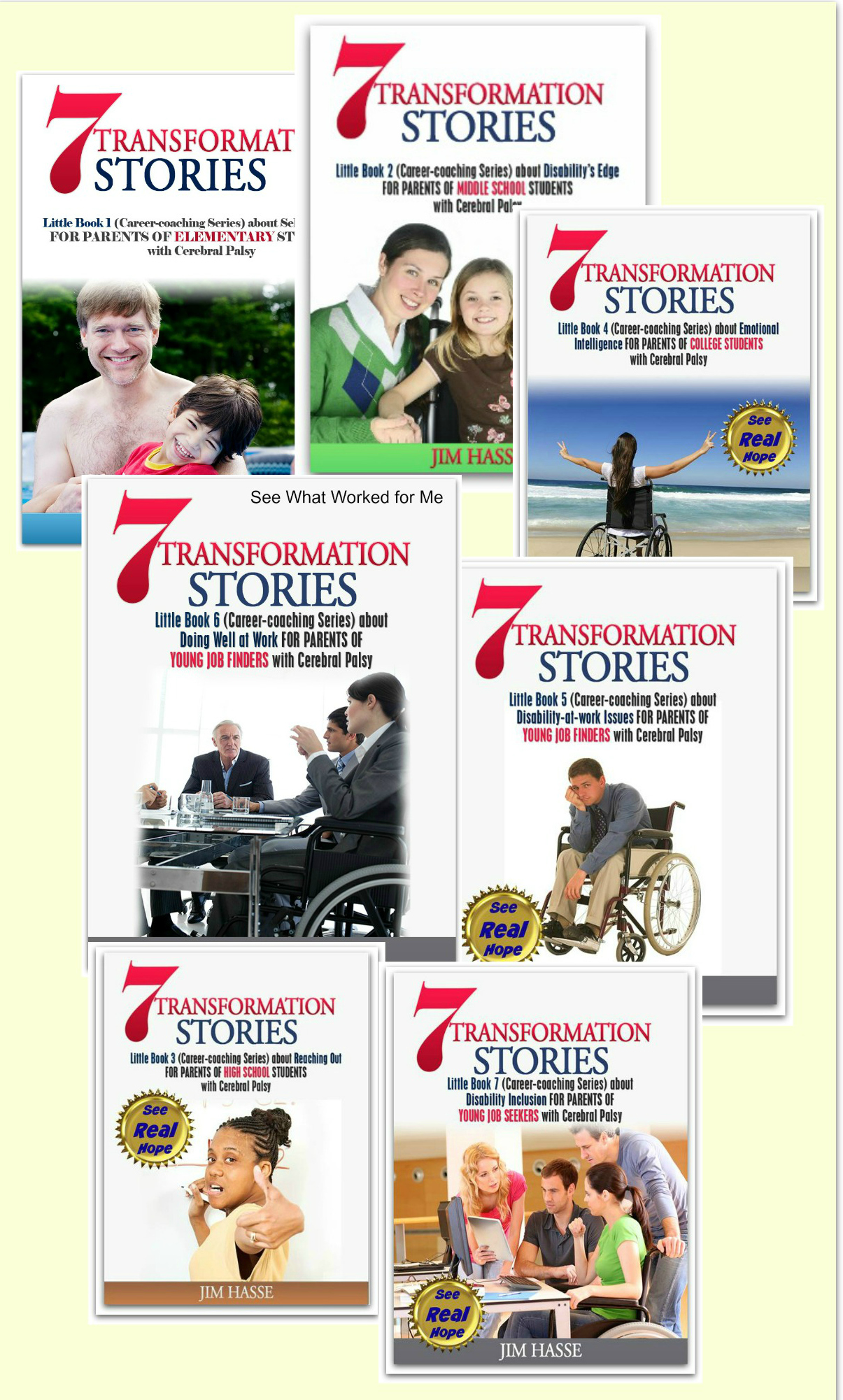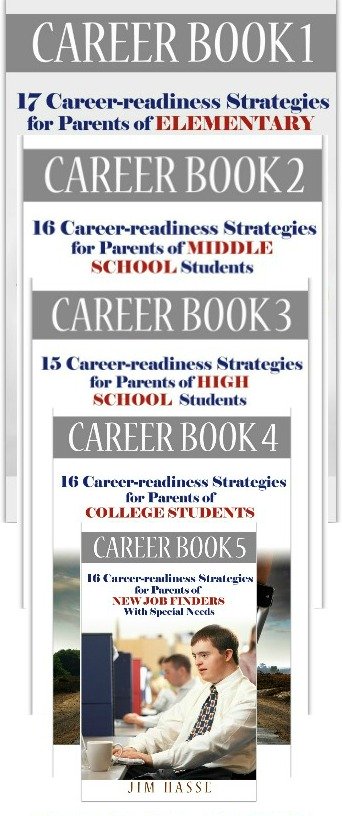Cerebral Palsy Answers: Career Builders for Your Middle School Student
By Jim Hasse, ABC, GCDF, Disability Employment Expert
_________________________________________________________
Here are two cerebral palsy answers to the question your middle school student will most likely face when he or she enters tomorrow’s world of work. That question is: “You have CP. Why should I hire you?”
That question, of course, will probably not be asked at all. If it is, it will be so indirect that your youngster will need to be quite perceptive in determining what is unasked but needs answering.
Over the years, I have collected insights from others within the disability community which I believe are viable cerebral palsy answers to that unasked question. Those cerebral palsy answers can be boiled down to these two concepts: tenacity and innovation.
Tenacity learned
through patience and perseverance
Job candidates who can show they have developed patience through struggle in addressing their vulnerabilities can be prime applicants because they’ll likely help an employer reduce employee turnover and increase productivity. That’s one of my favorite cerebral palsy answers.
Business managers will be able to get a jump on competitors by tapping your youngster’s motivation – that personal drive honed by personal necessary you probably see in your youngster on a daily basis.
Smart employers will recognize that personal drive as a competitive edge they need to continue their success because your youngster will most likely stick with them through good times and bad. Those smart employers will also realize that your youngster will need an opportunity for on-the-job autonomy and personal growth under an umbrella of a compelling corporate vision – the essential ingredients for low employee turnover.
Many employees today remain on the job for about 23 to 24
months, according to the U.S. Bureau of Labor Statistics.
Why?
The social contract between employer and employee is long gone. That social contract said, in essence: “Stick with me as your employer, and I’ll take care of you. I’ll train you and promote you to positions of higher authority when you prove that you’ve used that training to make yourself qualified for those positions. As part of this agreement, I’ll compensate you fairly in terms of salary, bonuses, pensions etc.”
Today employees are mostly on their own. They’re personally responsible for their own career development and their retirement planning. And, they may have sizable debt accumulated over the years they spent gaining an education.
They job hop because they assume that’s the quickest way to “get ahead,” gain more responsibility and pay off their student loans, buy a home, raise a family etc.
Besides, they find today’s jobs in many sectors offer little challenge. Those jobs are well defined, can be learned fairly quickly and soon become routine – offering little opportunity for real learning. Learning, after all, stops when a task becomes routine.
So, today’s workplace is generally set up to encourage effective employees
to “move on.” After all, today’s young people have spent 20 or more years in a
“learning environment,” and now, all of a sudden, they feel that their learning
has stopped. They get bored with routine.
I have personally experienced that frustration, but, as a person with CP, I’m also continually challenged simply due to my physical circumstances. That's my cerebral palsy answer.
Walking, for instance, is always a conscious effort for me because I know one misstep, particularly on wet tile or on an uneven sidewalk, can mean I’ll fall, gash up my knuckles etc.
That’s why I buy special non-skid tips for my crutches. That’s why I recently I found and bought a light-weight electric scooter that I can carry in the trunk of our car and skip the crutches altogether when Pam and I go to the shopping mall. The lithium battery only weighs two pounds and saves a lot of hefty lifting (the battery on my older scooter weighs 19 pounds).
In short, I catch myself always looking ahead, anticipating what could happen – even in my work. I don’t mind mundane work because I see the big picture. That, in itself, is a cerebral palsy answer.
I’ve gone through the rehab routine – lots of purposeful (and often lonely) practice that is always tough but sometimes shows results and means a better life for me.
Learning how to live just a little bit better with my CP takes time and energy. Maybe that’s why I don’t get bored very often. I stick with a task because, in various ways, it’s always new to me in the sense that it’s not routine and offers the challenge (and potential outcome) I need.
In conversations with your junior high school youngster, find opportunities to check if this “perseverance” concept is one of the cerebral palsy answers which ring true for him or her and which could potentially be the cornerstone of a future job marketing campaign.

Innovation honed
through problem-solving
ability
Personal necessity has driven my success in business and, fortunately, I’ve worked in businesses which have allowed me to transfer my personal problem solving skills to workplace challenges.
You’ll find that orientation in many job candidates with disabilities, who have developed the habit of continually stretching themselves so they can live a little bit better with their vulnerabilities.
People who know how to use their own best judgment are one of the keys to innovation (and success) in the 21st Century.
That was even true in 1956. My physical therapist was reluctant to recommend crutches for me because she thought I would become too dependent on them and that they would prevent me from learning how to walk independently without them. I had my doubts about her reluctance, and that doubt turned out to be one of my cerebral palsy answers.
So, in 1962, I did some research and went out and bought some Canadian-style crutches myself (all before the Internet) because through high school and my first two years of college I found myself hugging the walls for stability and unable to cross streets safely without an “arm” from someone else.
At 76, I now have successfully developed a four-stage mobility strategy that works for me – all without the help of a state or private agency. I have my Fetterman forearm crutches (always in our car), my TravelScoot scooter in the trunk of our car, my Amigo scooter for getting around downtown Madison and my Invacare walk, which I use in our condo.
During the 1970s, I learned to transfer my personal problem solving ability to matters on the job. As a company editor and photographer, for instance, I saw an opportunity to dramatize our company’s entry into the whey processing business through unusual camera angles.
One day (before the advent of OSHA), I climbed 30 feet to a cat walk above the company’s new whey evaporator to capture a photo which emphasized the complexity of the just-finished stainless steel network.
I did it by leaving my crutches on the ground level and slowly climbing the cat walk’s stairs, using the railing and my camera’s tripod for stability.
I knew I could do it, and I captured photos I used in various publications for the following two years. But, at the time, I could see a mixture of doubt, fear and puzzlement in the faces of the workers as they watched me slowly carry out what I considered just another part of my job.
Now that I look back on that incident, I feel lucky to have worked within a company culture which was not hobbled by a spider web of internal rules and regulations. As employees, we generally understood that we were expected to use our own best judgment in performing our job tasks – even though we were bound to make mistakes sometimes, face the consequences and maybe retrace some steps to correct a situation.
I was engaged in helping the company be the best it could be because I knew we were all engaged in serving our dairy farmer members. I felt I had autonomy in carrying out the duties of my job, and I had an opportunity to develop my skills on the job.
Under that environment, I had an opportunity 20 years later to direct a company-wide communication audit during the early 1990s as the organization’s vice president of corporate communication.
My CEO had doubts about the usefulness of the audit, but he approved it and we found, through the results of audit, the steps we needed to take to improve communication at specific levels within the organization and at specific locations.
A corporate climate which fosters employee autonomy and personal growth under an umbrella of a compelling vision can be, at times, risky and sometimes messy but also rewarding. It can spawn innovation.
The company survived 30 years of major dairy industry reorganization through merger and consolidation, mainly, I think, because it was innovative. We could get things done.
And, in a way, I became an example of that “can do” spirit. My work became one of those cerebral palsy answers to the question, “Why is this guy working here?” – a query that could rightly come from those not familiar with “our” company situation, where vulnerability and ambiguity were not only tolerated but embraced.
Return from Cerebral Palsy Answers to Career Test
Go to Cerebral Palsy Career Builders
This is Creative Commons content. You can freely and legally use, share and repurpose it for non-commercial purposes only, provided you attach this sentence and the following attribution to it (including the two links):
Originally written and illustrated by Jim Hasse, ABC, GCDF, owner of Hasse Communication Counseling, LLC, who, as a person with cerebral palsy, served for 10 years as a vice president in a Fortune 500 company during his 29-year career in corporate communication. He’s an Accredited Business Communicator, certified as a Global Career Development Facilitator and author of 14 Amazon books about disability awareness and disability employment issues.





